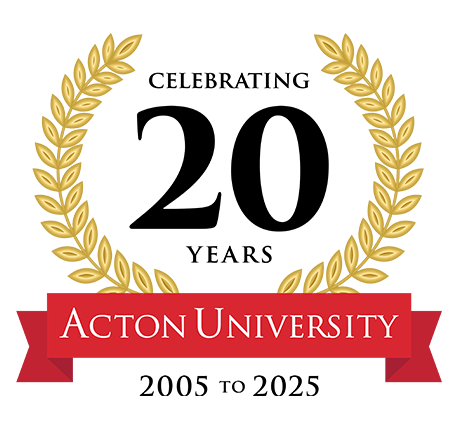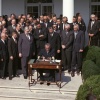R&L: Capital Research Center recently published a study of patterns of corporate philanthropy in the United States. Could you give us a brief summary of that study?
Johnson: Patterns of Corporate Philanthropy is an annual study of corporate public affairs giving. Using the Forbes 250 listing of America’s largest corporations, it examines contributions to public policy groups–not traditional service charities, the arts, hospitals, etc.–because these groups increasingly determine the political, economic, and moral climate in which businesses and society must operate. In other words, these contributions are highly leveraged.
The study proves that America’s largest corporations continue to fail the tests both of genuine compassion and common sense. In 1989 almost $28 million were given to philanthropy. For every dollar major corporations or their foundations gave to public interest groups whose programs supposedly are designed to help the poor and increase economic opportunity, more than two dollars went to groups seeking to expand public control and political regulation of private sector initiatives.
For example Aetna, American Express, AT&T, Exxon, and ten others support the Children’s Defense Fund, which favors higher excise and other taxes and greatly expanded federal government “entitlement” programs that promote dependency. Another example is broad corporate support of the NAACP and the NAACP Legal Defense and Education Fund, groups that oppose the Milwaukee educational voucher plan to allow educational choice and expanded opportunity for mostly black inner-city students. Additionally, the NAACP favors an increase in the minimum wage that would prevent less-skilled workers from entering the job market, and supports minority set-aside and affirmative action programs that would give more control over corporate hiring and promotion policies, hurting the very people they purport to help.
R&L: How do clergy contribute to the patterns of corporate philanthropy in the United States?
Johnson: Clergy of all denominations influence patterns of corporate and other charitable giving by working through philanthropic trade associations, sitting on the boards of grantmaking foundations, and organizing advocacy groups working on these issues.
Very often religious leaders are proponents of the social gospel and liberation theology. Products of 1960s radicalism include James Joseph, president of the Council on Foundations, who received his theological training at Yale in the early ’60s and was ordained in the United Churches of Christ. He chaired the Special Commission on Racism and Development of the World Council of Churches and held positions at Cummins Foundation and in the Carter Administration. The Council’s 1200 members control $3.6 billion in charitable giving annually.
Religious organizations are heavily involved in the corporate responsibility, progressive philanthropy, and socially responsible investing movements. One of the principal groups is the Interfaith Center on Corporate Responsibility, a coalition of more than 200 mainly Catholic orders, dioceses, and pension funds, which has organized boycotts against what it sees as “socially irresponsible” companies. It is a consultant to pension funds and mutual funds and acts as a clearinghouse for information on conscience investing. Timothy Smith, ICCR’s founder and leader, received a Master of Divinity degree from Union Theological Seminary. According to Smith, as of 1985, “The Interfaith Center’s church members have $10 million invested.”
Much of ICCR’s funding has been filtered through the National Council of Churches. It was the NCC’s Commission on Stewardship that distributed a book calling for “the extrication of stewardship from its almost indelible association with economic capitalism” and a “new look at the socialist alternative….” Funding has also come from the Youth Project (now know as the Partnership for America), a principal source of funds for the activist left in America.
Some have been critical of ICCR’s emphasis on such issues as the environment and South Africa, while at the same time largely ignoring the abortion issue. Groups such as NETWORK, Christic Institute, and American Friends Service Committee also claim a religious identity.
R&L: During the last twenty years or so, the emphasis of religious leaders has changed to being more concerned with material well-being for individuals from a more traditional concern for spiritual welfare. Do you see a correlation between this change and changes in corporate giving? Has this change been reflected in church attendance?
Johnson: The shift in emphasis of religious leaders coincided with the emergence of a host of movements born of 1960s radicalism, i.e., the environmental, feminist, consumer, and peace movements, and, of course, the progressive philanthropy movement that was created to fund these various causes. Thus, at a minimum, one can argue that, as part of a larger movement, the religious changes were linked to changes in corporate philanthropy. The two were more directly related in that clergy became directly involved in progressive philanthropy.
As to your second point, there can be no doubt that the changes in the church have paralleled a steady decline in attendance. In my opinion, that decline was a direct result of the church’s liberalization.
R & L: How has this change in the emphasis of religious leaders changed patterns of corporate philanthropy?
Johnson: Just as the changes have politicized the church, so, too, they have politicized charity. By emphasizing “social justice” over matters of faith, religious leaders put political and economic concerns on a par with traditional charities.
Furthermore, those involved in funding non-profit advocacy organizations are closely associated with the changes in religion. The large foundations which form the core of groups like the Council on Foundations and Independent Sector (leaders in promoting progressive philanthropy) have long been identified with theological liberalism. One Council newsletter declared that “Economics = Ecumenics,” and a Council study praised churches that moved from “only church-related activity” to “advocacy, social change, social action, the influencing of policy, and justice and equity.” An article in COF’s monthly, Foundation News, lauded church groups that sought “change in the entire social structure as it affects the needy, such as advocacy activities or alternative investing programs.” Clearly, with clergy taking a leading role in the philanthropic community, one sees a direct relationship between the shift in emphasis of many religious leaders–the emergence of liberation theology–and the changes in corporate giving.
The shift in emphasis has also affected the churches’ own charity as evidenced by the Campaign for Human Development of the Catholic Church, which supports political empowerment instead of traditional health care or relief programs. In 1990 its budget was over $9 million, and the list of groups it gave money to read like a Who’s Who of the American left. Implicit in CHD’s literature is the notion that free markets are institutionally corrupt and that the injustice they are combatting is intrinsic to capitalism. Not only does CHD’s view of the world run completely counter to tradition Christian theology, but its programs hurt the people they claim to help, namely, the poor. The groups it supports hinder advancement by channeling money away from productive causes and into coercive ones that discourage personal initiative and promote class warfare.
R&L: You were the White House Deputy Personnel Director in the early days of the Reagan administration. At that time it seemed that government programs might be able to make a change from the overtly evangelical but somewhat socialist tenor of the Carter administration to something more traditionally religious. Did that change ever take effect, or was the perception not valid?
Johnson: President Reagan–through his ability to communicate to the people– induced a significant change in the mood of the country, re-invigorating its spiritual vitality by promoting traditional family values and greater emphasis on God. This did more than any legislation could have. Additionally, through his court appointments, President Reagan probably made it easier for local governments and public institutions to promote religious values. Since it has been reported widely that church attendance is up and family life is being given greater importance, some changes must have occurred.
R&L: We have heard ad infinitum that the 1980s were the “greed decade.” Is this a valid assessment, and has a change taken place in the last two years?
Johnson: I cannot see any validity in referring to the ’80s as the decade of greed. This implies that people in the ’80s were somehow different from people of other generations. What happened in the ’80s was that economic policies were initiated which encouraged the creation of wealth by enabling people to pursue their dreams and utilize their talents more effectively. By removing the burden of high taxes and over-regulation, the administration created unprecedented economic growth that benefited everyone. What is different in the ’90s is not a change in people’s ambition to succeed but rather, a change in the climate they must operate under. We have higher taxes and spending and more regulation, so naturally people’s drive is inhibited.
Additionally, charitable contributions in the United States have increased each year for well over thirty-five years. The 1980s showed a dramatic increase in giving, reflecting the country’s unprecedented economic growth. Total charitable giving of roughly $48 billion in 1980 grew to $122 billion by 1990. I would hardly characterize that as a decade of greed.
It is difficult to say yet what the record for the 1990s will be, but the rate of growth in giving dropped from over twelve percent in 1988 to five and three quarters percent in 1990–the latest year for which we have complete data. Clearly the 1980s policies that encouraged the creation of wealth and increased disposable income–such as lower tax and regulatory burdens–stimulated charitable giving.
R&L: Do you think the people in the pews have had an impact on the social teaching of churches? More specifically, do you think Pope John Paul’s encyclical, Centesimus Annus, shows the effects of grass roots movements compared with such documents as the Bishops Pastoral letter and programs like the Campaign for Human Development?
Johnson: Lay people have consistently proven to be less radical and less hostile to the free market than much of the clergy. Present conservative trends, for example, in the Roman Catholic Church, have centered on lay groups. The Pope’s encyclical, Centesimus Annus, is not only more in tune with these trends among the laity and the momentous changes in the world as a whole but also with the traditional social teaching of the Catholic church. It shows an understanding that capitalism provides the greatest opportunity for social advancement to the highest number of people and that political freedom and economic freedom go hand in hand. Statements from mainline Protestant denominations and the American Catholic bishops, on the other hand, as well as from the Campaign for Human Development, are out of step with current trends. Centesimus Annus is a bold and needed correction to a leftward drift among clergy, particularly the bishops in the United States.












